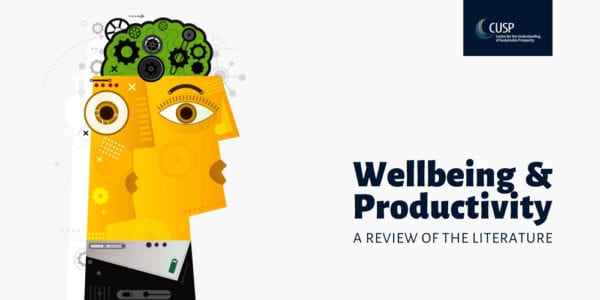Pursuing productivity—better ways for business, people and planet
Businesses want to be more productive, but do not always know how to improve. A recent review from CUSP highlights how different approaches have very different implications for businesses, their employees and the planet. In this blog, Amy Isham from CUSP and Helen Fitzhugh from the PrOPEL Hub reflect on three common ideas about pursuing productivity growth and what these different approaches mean in practice. This blog also appeared on PrOPEL Hub website.

Just work harder?
Let’s start with an obvious question. If you want employees to be more productive, why not give them more work to do, but no more time, training or other resources to do it? While in the short-term this might help your business past a moment of crisis, indications are that if continued, it will soon cause issues. Increasing workloads without appropriate resourcing is a short-sighted way of trying to increase productivity because it has negative consequences for the business, the employees and the planet. Employees reporting excessive workload tend to report:
- greater anxiety,
- lower happiness and
- more job dissatisfaction.
Trying to get employees to produce more in the same amount of time also has the potential to harm the environment where it intensifies (usually non-renewable) energy and material use. At the same time, higher job demands can undermine work quality. One example of this is in the healthcare sector. Here, being allocated more patients in less time can lead to patients receiving lower quality, less personalised care.
Tech will save us?
So, if it is clear we cannot rely on simply working a bit harder long-term, maybe harnessing the latest information and communication technology (ICT) is the answer? The evidence suggests that this approach might be more successful for businesses than increasing job demands, but unfortunately there are also drawbacks for people and planet. Businesses can see increase productivity if employees are appropriately trained to use relevant ICT applications. The effects of ICT on employee wellbeing and the environment, however, are more mixed:
- Employees can benefit from ICT as it affords them greater autonomy and more flexible working patterns.
- But, it can cause them stress when not functioning properly and promote sedentary lifestyles.
Likewise, the ability to work from home may have positive consequences for the environment where travel emissions are reduced. However, there are issues surrounding the energy needed to produce and power ICT equipment and appropriate end-of-use recycling.
Focus on wellbeing
So, is there a way to improve productivity that is better for business, people and planet? There is one approach with the potential to have positive consequences for all three stakeholders, namely investing directly in employee wellbeing. Raising employee wellbeing can benefit business outcomes. Happier workers have been shown to be more productive, a trend known as the happy-productive worker thesis. Evidence-based ways of improving employee wellbeing are also not typically environmentally costly. For example, fostering quality relationships in the workplace can help to improve health and wellbeing whilst requiring limited investment of materials and/or material energy. In addition, exposure to green space and time for exercise are usually not costly either and can help workers manage their own health.
Embedding a wellbeing focus
If focusing on workplace wellbeing is more likely to improve productivity without impacting harmfully on the work, employees or planet, why do some organisations find it hard? Potentially, it is because good quality interventions to improve employee wellbeing focus are not just isolated events – a wellbeing day here or a bowl of fruit there. Rather than trying to change things in one big gesture, organisations need to slowly and surely embed a wellbeing focus in their working practices by following five principles:
- Consult and include the workforce on what is necessary in your workplace
- Make sure any attempts you make to improve wellbeing are coherent (not patchy) across the organisation
- Commit to learning, adapting and persisting so that your approach is not short-lived if you hit a challenge
- Make sure your wellbeing approach does not clash with existing work systems or approaches or employees may become cynical about your intentions
- Be creative to challenge problematic cultural norms (like habits of long working hours).
Following these principles usually leads organisations to understand more about what really matters to employees – high quality terms and conditions, good management, good working relationships and support during hard times.
Productivity that works for people and planet
To sum up, pursuing productivity growth through long-term, principled investment in employee wellbeing is important. Businesses that prioritise employee wellbeing, rather than pushing productivity through raising demands or expecting a technological miracle are more likely to be pleasantly surprised by productivity gains. Given the current pressing issues of climate change and COVID-19, a wellbeing focus is more important than ever to align the interests of business, people and planet.
For more detail on the evidence behind this blog, see:
- The evidence review produced by CUSP: https://cusp.ac.uk/themes/s1/wp22/
- The workplace wellbeing programme from the What Works Centre for Wellbeing: https://whatworkswellbeing.org/resources/five-principles-to-improve-workplace-wellbeing/
Event
- For more on the relationship between wellbeing and productivity, register for the upcoming joint CUSP/ PrOPEL workshop on 9 November, as part of this year’s ESRC Festival of Social Science.



